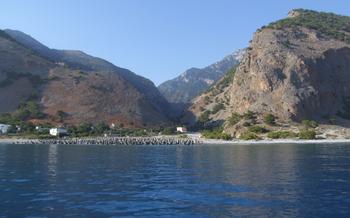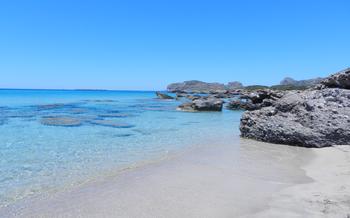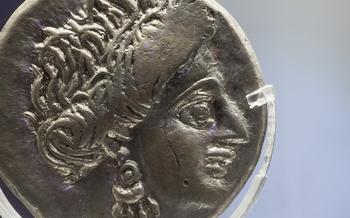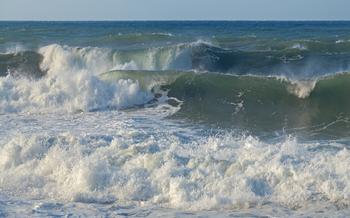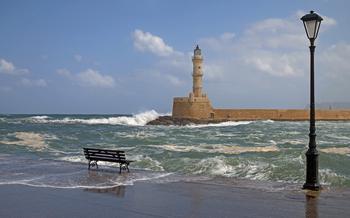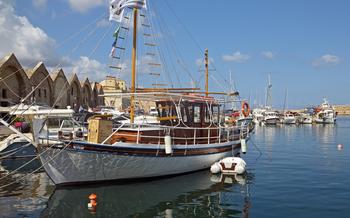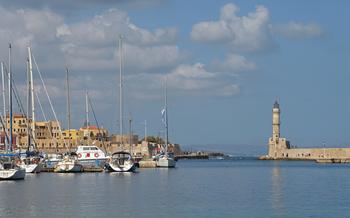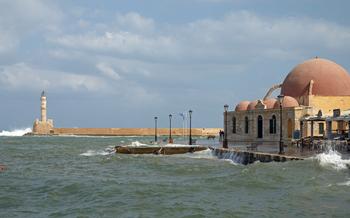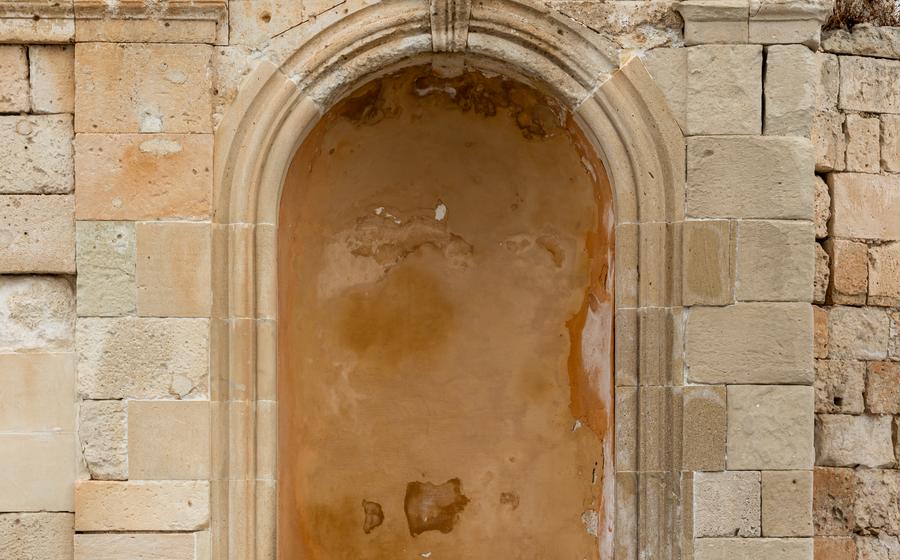
Ancient Falassarna
- Historical Background
- Location and Accessibility:
- Key Archaeological Sites
- Tips for Visitors
- Ancient Theater
- Temple of Apollo Delphinios: A Sacred Legacy
- City Walls and Fortifications:
- Necropolis
- Museum of Falassarna: A Treasure Trove of Ancient Artifacts
- Beaches of Falassarna: A Haven for Sun, Sand, and Sea
- Local Cuisine
- Nearby Attractions
- Accommodation
- Insider Tip: Unveil the Hidden Charms of Falassarna
Historical Background
Falassarna, a historic city in western Crete, boasts a rich and fascinating past dating back to ancient times. Once a prominent city-state, it was renowned for its strategic location on the western tip of the island. Over the centuries, Falassarna has been influenced by various civilizations, including the Minoans, Greeks, Romans, and Venetians, each leaving their mark on the city's architecture, culture, and way of life.
Archaeological excavations have unearthed a wealth of artifacts and ruins, shedding light on the city's vibrant history. The ancient theater, temple, city walls, and necropolis are among the most notable discoveries, providing valuable insights into the lives and customs of Falassarna's inhabitants. Ongoing excavations continue to uncover new treasures, adding to our understanding of this ancient city.
One of the most intriguing aspects of Falassarna's history is its role as a significant port during the Roman and Venetian periods. Its strategic position facilitated trade and commerce, making it a bustling hub of maritime activity. The city's prosperity is evident in the grandeur of its buildings and the wealth of imported goods found during excavations.
Falassarna's legacy lives on in the stories and legends passed down through generations. It remains a place of profound historical importance, preserving the echoes of ancient civilizations that once thrived on this land.
Location and Accessibility:
-
Falassarna is situated in the westernmost part of Crete, about 56 kilometers from the city of Chania and 42 kilometers from the town of Kissamos.
-
To reach Falassarna from Chania, you can take the National Road towards Kissamos and follow the signs to Falassarna. The drive takes about an hour and 15 minutes.
-
From Kissamos, you can take the coastal road towards Falassarna, which offers stunning views of the sea and the surrounding countryside. The drive takes approximately 45 minutes.
-
Public transportation to Falassarna is limited, with only a few buses running daily from Chania and Kissamos. However, renting a car is highly recommended for a more flexible and independent exploration of the site and the surrounding area.
Key Archaeological Sites
- Falassarna's Ancient Theater
The ancient theater of Falassarna is a remarkable spectacle, a testament to the city's cultural and artistic heritage. Built in the 4th century BC, this impressive structure could accommodate up to 4,000 spectators. Its well-preserved seating area offers a breathtaking view of the surrounding landscape, with the azure sea serving as a backdrop. In ancient times, the theater hosted theatrical performances, musical concerts, and religious ceremonies, creating a vibrant atmosphere that echoed through the hills. Today, the theater occasionally hosts cultural events and performances, allowing visitors to experience the magic of this ancient venue.
- Temple of Apollo Delphinios
Dedicated to Apollo Delphinios, the protector of sailors and travelers, this temple was a focal point of religious life in Falassarna. Built in the 5th century BC, it showcased a unique architectural style, blending Greek and Egyptian elements. The temple's ruins reveal an impressive facade adorned with intricate carvings and sculptures. Archaeological excavations have unearthed various artifacts, including pottery, inscriptions, and votive offerings, providing valuable insights into the beliefs and practices of the ancient inhabitants.
- City Walls and Fortifications
Falassarna's strategic location made it a prime target for invasions and attacks. To protect themselves, the city's inhabitants constructed a formidable system of fortifications, including towering walls, fortified towers, and elaborate gates. These impressive structures, built in the 4th century BC, were designed to withstand enemy assaults and safeguard the city's autonomy. Visitors can still admire the remnants of these defensive structures, marveling at the ingenuity and resilience of the ancient Falassanians.
- Necropolis
Just outside the city walls lies the ancient necropolis, a solemn reminder of Falassarna's past. This extensive cemetery contains various types of tombs, from simple rock-cut chambers to elaborate family mausoleums. Archaeological excavations have revealed a wealth of artifacts, including jewelry, pottery, and personal belongings, offering glimpses into the funerary customs and beliefs of the ancient inhabitants. The necropolis serves as a poignant testament to the lives and legacies of those who once called Falassarna home.
Tips for Visitors
Exploring the ancient city of Falassarna requires some preparation to ensure a comfortable and enjoyable experience. Firstly, choose comfortable clothing and sturdy footwear suitable for walking on uneven terrain. The site offers limited shade, so remember to bring a hat, sunscreen, and plenty of water, especially during the hot summer months. To avoid the crowds, plan your visit early in the morning or late in the afternoon. Be aware that facilities at the site are limited, so bring any necessary items with you. Finally, embrace the opportunity to disconnect and immerse yourself in the ancient atmosphere of Falassarna. Leave your electronic devices behind and enjoy the tranquility and beauty of this historical gem.
Ancient Theater
The ancient theater of Falassarna is an impressive reminder of the city's cultural significance. Built in the 4th century BC, the theater is located on a hillside, offering breathtaking views of the surrounding landscape. With a seating capacity of over 500 spectators, it was used for theatrical performances, musical concerts, and religious ceremonies.
The theater's architectural features are well-preserved, showcasing the skill and craftsmanship of ancient Greek builders. The stage is adorned with intricate carvings, and the acoustics are remarkable, allowing for clear sound transmission even to the furthest seats.
In ancient times, the theater was a vibrant hub for entertainment and cultural exchange. Today, it occasionally hosts performances and events, allowing visitors to experience the theater's magic and transport themselves back in time.
Temple of Apollo Delphinios: A Sacred Legacy
Amidst the ruins of Falassarna, the Temple of Apollo Delphinios stands as a testament to the deep-rooted religious beliefs of the ancient Greeks. Dedicated to Apollo, the god of prophecy, healing, and music, this sacred site played a pivotal role in the spiritual and cultural life of the city.
Built in the 4th century BC, the temple showcased exquisite architectural features, reflecting the advanced skills of ancient Greek builders. Its Doric columns, finely carved friezes, and intricate pediments added to its grandeur and significance.
Legend has it that the temple was constructed on the spot where a dolphin guided a ship carrying a sacred statue of Apollo to Falassarna's shores. This mythical event further solidified the temple's importance as a place of worship and pilgrimage.
Archaeological excavations have unearthed a wealth of artifacts and offerings within the temple, providing valuable insights into the religious practices and rituals of the time. Statues, pottery, and inscriptions have shed light on the significance of Apollo's cult and the devotion of the ancient inhabitants of Falassarna.
Today, visitors can explore the evocative ruins of the Temple of Apollo Delphinios and imagine the grandeur of this sacred space. While time and natural elements have taken their toll, the temple's enduring presence serves as a reminder of the enduring power of faith and the rich history that permeates every corner of Falassarna.
City Walls and Fortifications:
Falassarna's impressive city walls and fortifications stand as a testament to the city's strategic importance and defensive capabilities. Constructed using massive stone blocks, these walls once encircled the entire city, providing protection from potential invaders. The walls featured several towers and gates, allowing for controlled access and surveillance. Their height and thickness provided an additional layer of defense, making Falassarna a formidable stronghold.
The strategic location of Falassarna, on a narrow isthmus between two bays, made it a vital point of control for seafaring trade routes. The city's fortifications allowed it to protect its harbor and the lucrative trade that passed through it. The walls also served as a deterrent against attacks from land, ensuring the safety and prosperity of Falassarna's inhabitants.
Today, visitors can explore the remains of these ancient fortifications, marveling at their size and engineering prowess. The walls offer a glimpse into the city's past, when it was a bustling center of commerce and a symbol of power and resilience.
Necropolis
The ancient necropolis of Falassarna is a fascinating glimpse into the funerary customs and beliefs of the ancient inhabitants. Located just outside the city walls, the cemetery contains a variety of tombs, including rock-cut and chamber tombs. These tombs were used to bury the dead, along with their personal belongings and offerings to the afterlife.
Excavations at the necropolis have revealed a wealth of information about the ancient Falassarnans. The tombs contain a variety of grave goods, such as pottery, jewelry, and coins. These artifacts provide insight into the social status and wealth of the deceased. The tombs also contain skeletal remains, which have been studied to learn more about the health and diet of the ancient population.
The necropolis is a poignant reminder of the lives and deaths of the ancient Falassarnans. It is a place where visitors can learn about the past and reflect on the enduring power of human memory.
Museum of Falassarna: A Treasure Trove of Ancient Artifacts
The Museum of Falassarna is a treasure trove of artifacts and exhibits that showcase the rich history and cultural heritage of the ancient city. Located a short distance from the archaeological site, the museum houses a fascinating collection of artifacts unearthed during excavations at Falassarna and the surrounding area.
Visitors can explore a diverse range of exhibits, including pottery, sculptures, jewelry, coins, and tools that provide insights into the daily lives, customs, and artistic traditions of the ancient inhabitants. The museum also features informative displays and panels that explain the significance of the artifacts and the history of Falassarna.
A highlight of the museum is the collection of well-preserved sculptures, including statues of gods and goddesses, funerary reliefs, and architectural fragments. These sculptures offer a glimpse into the artistic skills and religious beliefs of the ancient Falassarna people.
The museum's collection of pottery is equally impressive, showcasing a variety of styles and techniques used by ancient potters. Visitors can admire intricate vases, bowls, and jugs decorated with colorful motifs and patterns, providing insights into the domestic and ceremonial life of the city.
The Museum of Falassarna plays a crucial role in preserving and showcasing the rich cultural heritage of the ancient city. It is a must-visit destination for anyone interested in exploring the history and significance of this captivating archaeological site.
Beaches of Falassarna: A Haven for Sun, Sand, and Sea
The archaeological site at Falassarna may be the star attraction, but the beaches that grace its shores are equally alluring. With their pristine sands, crystal-clear waters, and shallow, calm conditions, these beaches offer a perfect respite from exploring ancient ruins. Whether you're looking to swim, snorkel, sunbathe, or simply relax and soak up the Mediterranean sun, Falassarna's beaches have something for everyone.
For those seeking water sports, there are plenty of options available, including paddleboarding, kayaking, and windsurfing. Several beachside vendors rent out equipment and offer lessons for beginners.
After a day of exploring and enjoying the beaches, head to one of the local tavernas or restaurants to savor the delicious flavors of Cretan cuisine. Fresh seafood, traditional dishes, and local wines await you, offering a culinary experience that complements the historical and natural wonders of Falassarna.
Combining a visit to the archaeological site with a relaxing day at the beach is the perfect way to experience the best of Falassarna. Immerse yourself in the history of this ancient city, then let the beaches soothe your soul and rejuvenate your senses.
Local Cuisine
The flavors of Falassarna extend beyond its historical ruins, inviting you to savor the culinary delights of the region. The cuisine here is a harmonious blend of traditional Cretan and Mediterranean influences, showcasing the freshest ingredients and local specialties.
Indulge in the bounty of the sea with freshly caught seafood, a staple in the local diet. Grilled octopus, succulent shrimp, and tender calamari are just a few of the delicacies waiting to tantalize your taste buds.
Olive oil, a liquid gold revered throughout Crete, plays a starring role in Falassarna's cuisine. Drizzle it over salads, freshly baked bread, or grilled vegetables to enhance their flavors.
For a taste of traditional Cretan dishes, try dakos, a simple yet flavorful combination of barley rusks topped with tomatoes, feta cheese, and olive oil. Moussaka, a hearty casserole made with layers of eggplant, potatoes, and minced meat, is another must-try.
To savor the local culinary delights, head to one of the tavernas or restaurants near the beach. These charming establishments offer a warm ambiance and panoramic views, allowing you to enjoy your meal while basking in the beauty of Falassarna.
During your stay, keep an eye out for food festivals or culinary events held in the area. These celebrations provide a fantastic opportunity to sample a wide variety of local specialties and immerse yourself in the vibrant culinary culture of Crete.
Nearby Attractions
-
Beyond the ancient treasures of Falassarna, the region offers a plethora of captivating attractions to enrich your Cretan adventure.
-
Just a stone's throw away lies the ancient city of Polyrrinia, where you can explore the ruins of a once-thriving settlement, including a well-preserved theater and remnants of ancient temples.
-
For a taste of Venetian history, embark on a scenic boat trip to the Venetian fortress of Gramvousa, perched atop a rugged islet off the coast. Explore its imposing fortifications and soak in the breathtaking views of the surrounding sea.
-
Immerse yourself in the charm of traditional Cretan villages by visiting Platanos, nestled amidst olive groves and offering a glimpse into the authentic lifestyle of the island.
-
Nature enthusiasts can embark on an unforgettable boat excursion to the enchanting island of Elafonisi, renowned for its pristine pink-sand beaches and crystal-clear turquoise waters.
-
For those seeking adventure, the Samaria Gorge, one of Europe's longest gorges, offers a challenging yet rewarding hiking experience through stunning landscapes and diverse flora and fauna.
-
Discover the majestic peaks of the White Mountains, Crete's highest mountain range, by embarking on scenic hikes or mountain biking trails, offering panoramic views and a chance to explore traditional mountain villages.
Accommodation
When planning your visit to Falassarna, you'll find a range of accommodation options to suit different preferences and budgets. Hotels, guesthouses, and rental apartments are available in the area, offering comfortable stays with modern amenities. To secure the best options, it's advisable to book your accommodation in advance, especially during the peak tourist season. If you're looking for a more authentic experience, consider staying in one of the nearby villages, such as Platanos or Kissamos, which offer a glimpse into the traditional Cretan lifestyle. These villages provide a charming base from which to explore the region and immerse yourself in the local culture.
Insider Tip: Unveil the Hidden Charms of Falassarna
Beyond the allure of its ancient ruins, Falassarna conceals a treasure trove of hidden gems waiting to be discovered. For an unforgettable experience, rise early and witness the sun casting its golden rays upon the archaeological site. The tranquility of the morning, coupled with the breathtaking views, creates a magical ambiance that transports you back in time. Alternatively, linger until dusk when the sky transforms into a canvas of vibrant hues, casting a warm glow upon the ancient stones. For those seeking a secluded haven, venture off the beaten path to explore the pristine coves and secluded beaches that dot the surrounding coastline. These hidden gems offer a tranquil escape from the crowds, inviting you to immerse yourself in the beauty of nature and history.
